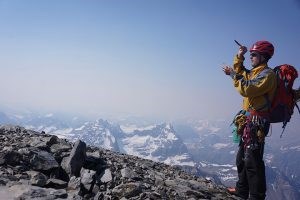
Amongst all the fanfare and celebrations for Canada 150, Jim Everard wanted to find a way to honour and recognize the Indigenous people who travelled through Jasper National Park long before is was federally protected land, but was unsure how to proceed.
After learning about the local Indigenous culture and history of this region he decided to purchase a smudge kit from the Samson Cree Nation and hike to the top of Mount Fryatt to hold a private smudge ceremony at its peak on July 26.
“The mountains are my cathedral and spiritual home,” said Everard, who lives in Toronto, but regularly visits the Rocky Mountains.
“There are a whole bunch of things we as non-Indigenous people can do, but for me this was just another opportunity to merge my historical love with mountains with a traditional ceremony of people who used to be here before they got kicked out.”
He acknowledged that some people could find his attempts at reconciliation as culturally inappropriate, but said that’s not what he was trying to do.
“If anybody thinks this is cultural appropriation I’d like to apologize,” said Everard, who left the smudging kit at the top of Mount Fryatt for others to use.
“I’m doing this to honour Indigenous peoples in my own way, in one of the only ways I think I can and it’s kind of a personal quest.”
While his act of reconciliation is a laudable effort, at least one expert said there are better ways people can reconcile with Indigenous people.
“I think it’s good that he’s interested in reconciliation, that he wants to learn more about indigenous cultural practices, but I think probably a more appropriate way to go about that would be staying in the Jasper region for a while and start making relationships and connections with the Indigenous community,” said Crystal Fraser, a University of Alberta PhD candidate who studied the history of residential schools in northern Canada.
Fraser, who is Gwich’in from Inuvik, NWT, recently joined forces with Dr. Sara Komarnisky, a history post-doctoral fellow, to publish a list of 150 acts of reconciliation Canadians can undertake for the final 150 days of 2017.
“The list is asking people to make reconciliation a part of their everyday ethos and life,” said Fraser.
For example she said the list includes asking Canadians to understand and acknowledge that Canada’s first Prime Minister Sir John. A Macdonald played a fundamental role in the creation of the residential school system.
Other examples include understanding why Canada 150 is not something to celebrate for many Indigenous peoples or supporting Indigenous authors by purchasing their books.
Smudge ceremonies did not make the list.
“To practice smudging it’s important to be respectful, you have to learn how to handle the herbs according to certain protocol so smudging isn’t really something that you can just watch someone do one time and go practice it on your own if you’re really trying to reconcile with Indigenous people,” said Fraser.
At the very least she said people should listen more and talk less and remember that good intentions can be harmful too.
The list of 150 ideas for reconciliation will be available to the public on Aug. 4 at www.activehistory.ca.
Paul Clarke
[email protected]
